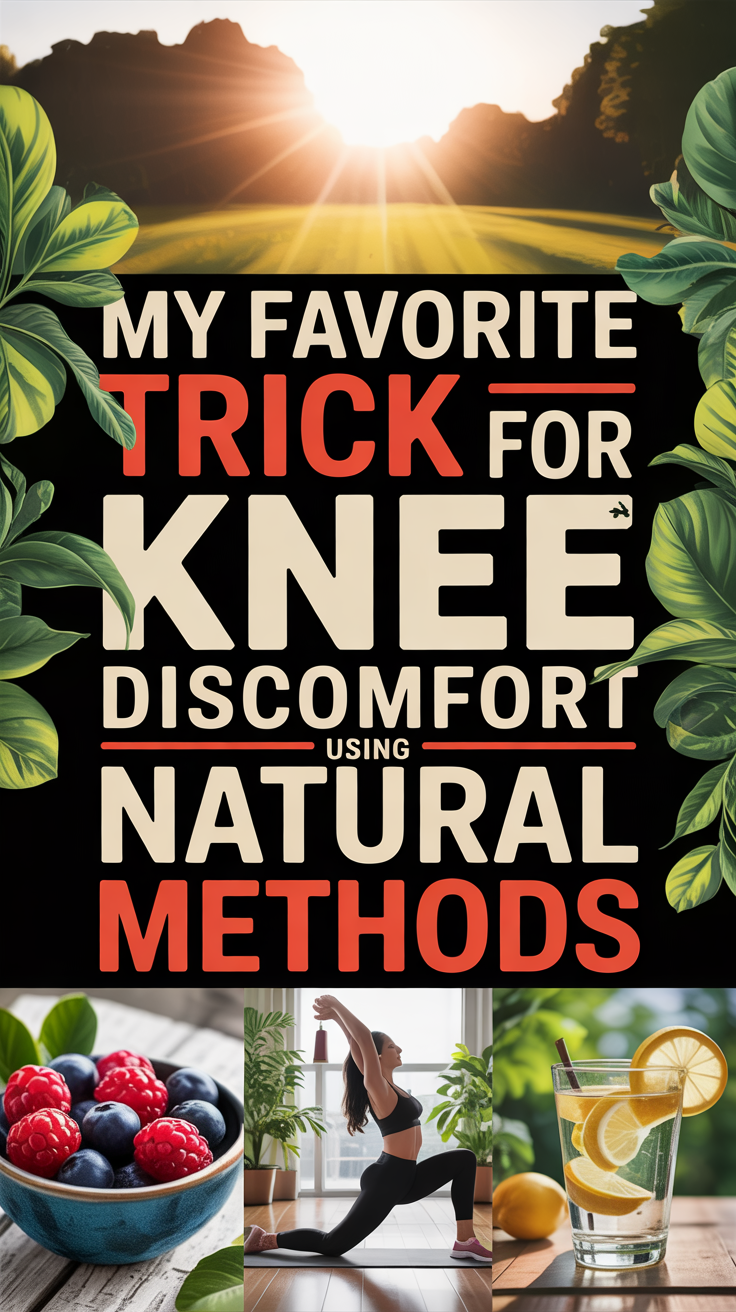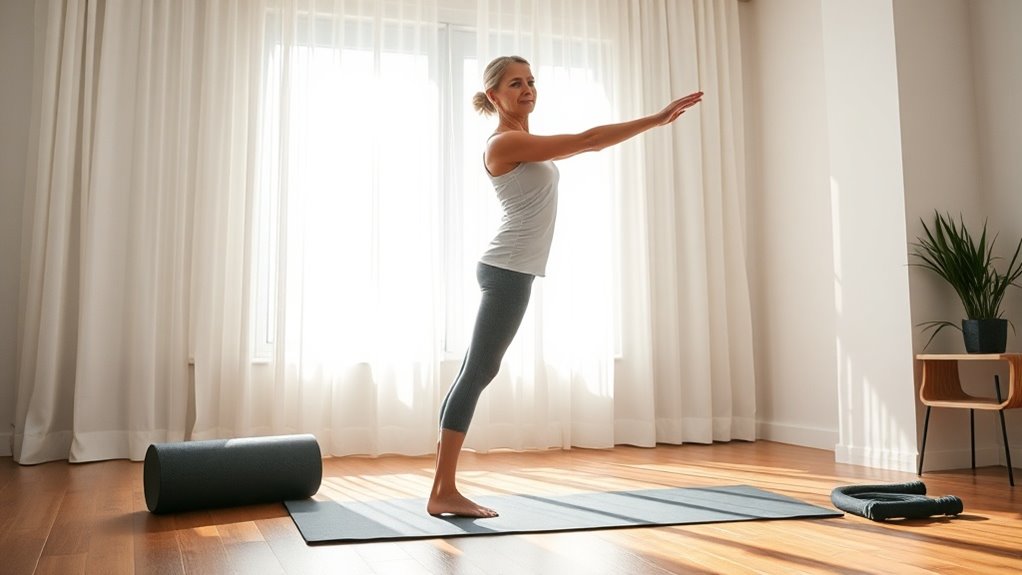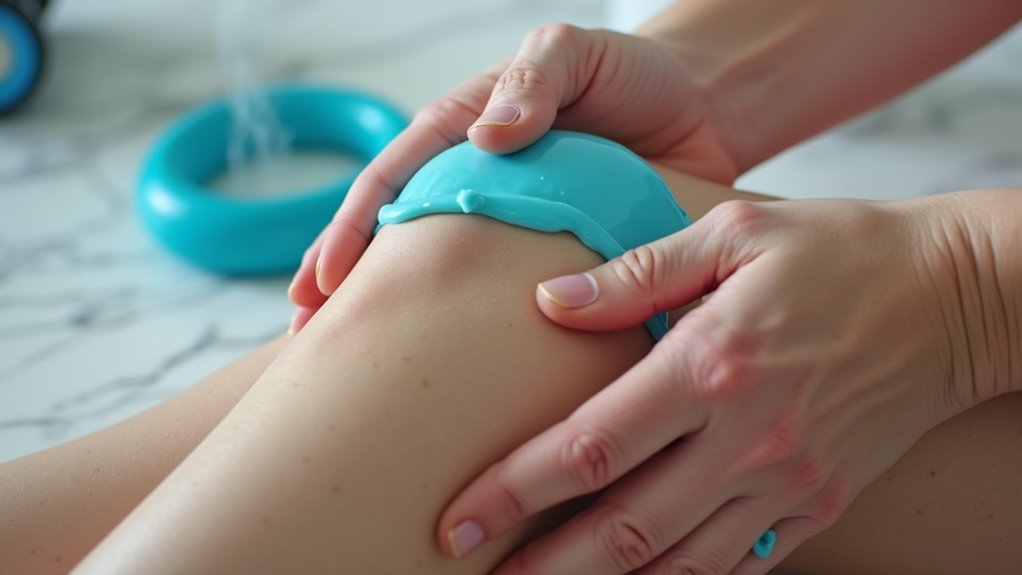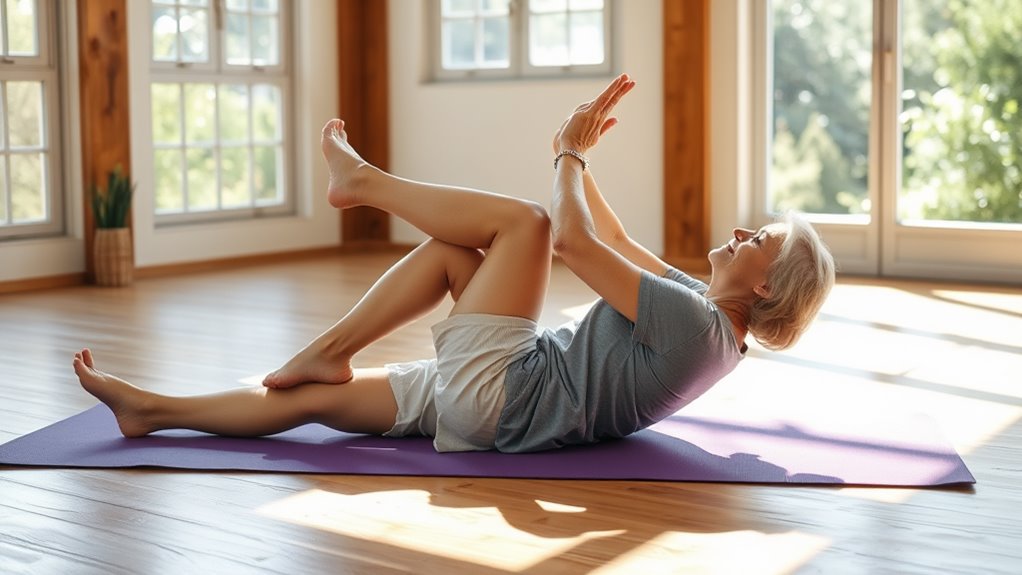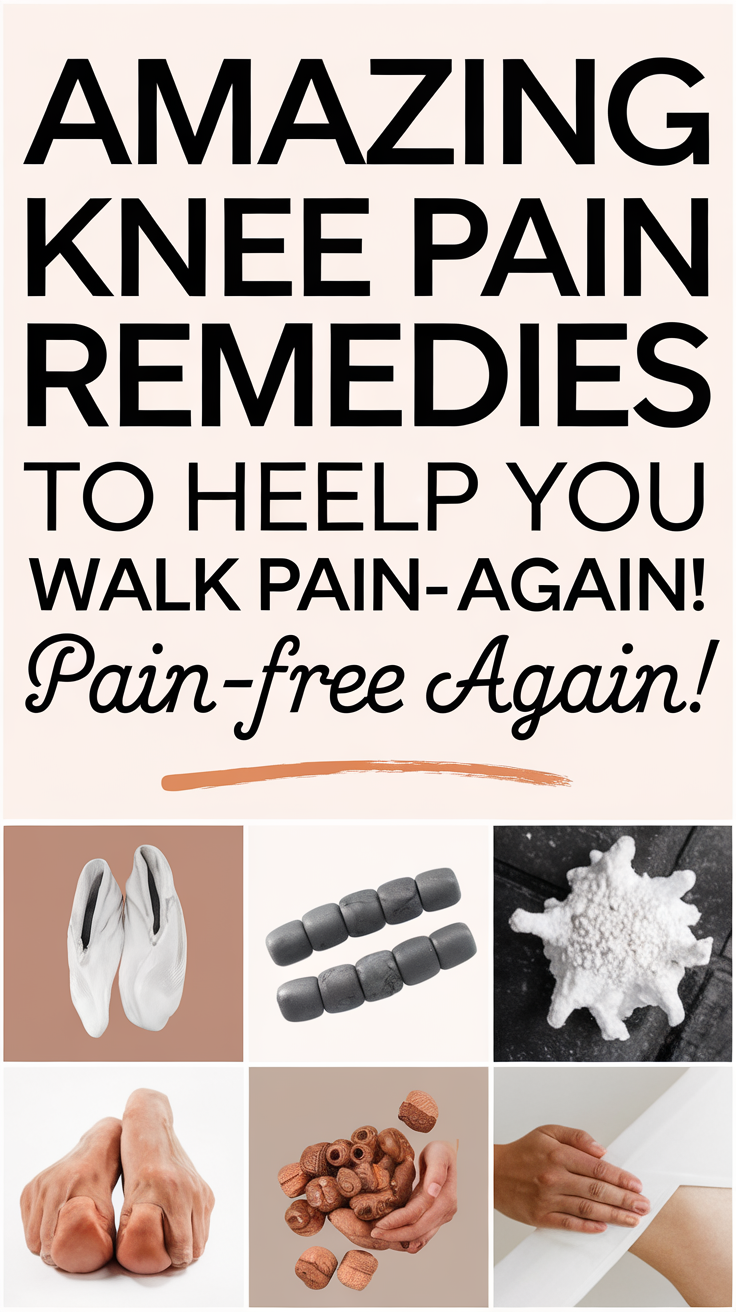My Favorite Trick for Knee Discomfort Using Natural Methods
If you’re dealing with knee discomfort, try incorporating natural methods like gentle exercises and anti-inflammatory foods into your routine. Regular stretches can boost flexibility, while omega-3s from salmon ease stiffness. Don’t forget to rest your knees and use the RICE protocol for acute pain. Making these small adjustments can lead to significant improvements in your comfort and mobility. There’s so much more to explore about enhancing joint health and easing knee pain in your day-to-day life.
Understanding Knee Discomfort: Causes and Symptoms
Have you ever wondered what’s really behind that knee discomfort you’ve been experiencing? Several factors could contribute, like injuries from sprains or torn cartilage, or even the wear and tear of aging. Common causes include osteoarthritis and runner’s knee, affecting active individuals.
If you’re carrying extra weight, that added stress can intensify your pain. You might also face joint stiffness or swelling, indicating inflammation. Knee pain is common across all ages and can result from a variety of causes.
Recognizing these symptoms is crucial for seeking effective knee pain relief remedies. By understanding the root causes, you can take proactive steps towards healing, whether through gentle exercise, weight management, or consulting a healthcare professional.
You deserve comfort and mobility; let’s work towards achieving that together.
The Power of the RICE Protocol for Acute Pain
How can you quickly ease acute knee pain and promote healing? The RICE protocol is your go-to solution.
Start by resting your knee to prevent further injury, then apply ice to numb pain and reduce inflammation. Incorporating the RICE method can effectively mitigate pain from various activities.
Next, use compression to diminish swelling and elevate your leg to encourage fluid drainage. The RICE protocol is effective for both athletic and everyday settings, making it an accessible option for everyone.
Incorporating these steps within the first 48 to 72 hours post-injury can significantly alleviate discomfort and speed up recovery.
Effective Temperature Therapy Techniques
When you’re dealing with knee discomfort, using temperature therapy can make a real difference in your relief strategy. Ice pack applications can help manage swelling, while heat therapy offers muscle relaxation and improved blood flow. Applying ice immediately after an injury can reduce swelling and inflammation, helping to alleviate pain more effectively. Additionally, alternating between hot and cold can provide effective pain management, ensuring both relaxation and reduced swelling. You might even find that a contrast therapy approach, alternating between hot and cold, gives you the best of both worlds for pain management.
Ice Pack Applications
Ice pack applications serve as a vital tool for managing knee discomfort, offering effective temperature therapy techniques that can make a real difference in your recovery journey.
By applying ice immediately after an injury, you can reduce blood flow and swelling, providing temporary relief. Ice reduces inflammation, which is essential for alleviating pain after an injury.
Wrap your ice pack in a towel to protect your skin, applying it for at least 20 minutes.
Elevating your knee helps enhance the benefits, promoting quicker healing.
Remember, if you feel increased pain while icing, consult a medical professional.
Prioritize consistency for maximum relief, and embrace the comfort it brings during your recovery process.
Heat Therapy Benefits
Heat therapy can be a game-changer for managing knee discomfort and improving your overall well-being. By applying warmth, you can increase blood flow, loosen stiff joints, and reduce muscle spasms. This gentle heat enhances flexibility and alleviates chronic pain. Additionally, heat therapy shines as the oldest, cheapest, safest complementary treatment available, widely supported by research for its effectiveness.
| Benefit | Description | Application |
|---|---|---|
| Increased Blood Flow | Delivers oxygen and nutrients | Heating pads or warm compresses |
| Joint Stiffness Relief | Loosens stiff joints | 10-15 mins of warmth |
| Chronic Pain Alleviation | Improves synovial fluid movement | Regular use, 2-3x daily |
| Enhanced Flexibility | Increases collagen elasticity | Combine with gentle stretches |
| Tissue Regeneration | Promotes healing through warmth | Optimal post-exercise relief |
Contrast Therapy Approach
Contrast therapy can be an effective way to tackle knee discomfort, bringing together the benefits of both heat and cold treatments.
This technique enhances circulation, reduces swelling, and promotes healing.
You might experience:
- A significant decrease in knee pain and swelling after just one session.
- Improved knee flexion and extension, making it easier to move.
- Enhanced overall satisfaction, with many patients rating their experience highly.
Gentle Exercises for Strengthening and Flexibility
When it comes to easing knee discomfort, gentle exercises like Tai Chi and water aerobics can work wonders for your strength and flexibility. You’ll find that adding movements like straight-leg raises not only builds muscle but also enhances your overall stability. Additionally, incorporating low-impact exercises into your routine can significantly alleviate stress on your knees and promote healing. Let’s explore how these activities can truly benefit your knees and improve your everyday life.
Tai Chi Benefits
Tai Chi can be a gentle yet powerful ally in strengthening your knees and enhancing flexibility.
By incorporating these mindful movements into your routine, you can experience a range of benefits:
- Pain Reduction: It effectively eases knee pain and improves function.
- Flexibility Enhancement: You’ll enhance your range of motion, supporting overall knee health.
- Accessibility: Tai Chi is low-impact, making it suitable for all ages and skill levels.
Embracing Tai Chi not only supports your physical health but also nurtures your mental well-being, helping you manage stress and cultivate a deeper sense of peace.
It’s truly a holistic practice.
Straight-Leg Raises
Strengthening your knees doesn’t have to be daunting, and straight-leg raises offer an effective, gentle way to enhance flexibility and muscle stability.
By performing these raises, you’ll target your quadriceps and hip flexors, providing the support your knees need without adding stress to the joint.
This exercise improves mobility and helps reduce pain, making it especially beneficial during rehabilitation.
Focus on slow movements to engage your core while lifting your leg, and don’t forget to listen to your body.
Aim for 10–15 repetitions, adjusting as needed to keep it pain-free and effective on your journey to stronger knees.
Water Aerobics Advantages
While straight-leg raises strengthen your knees effectively, water aerobics offers a gentle alternative that enhances both strength and flexibility.
This low-impact exercise can be particularly beneficial for your knee health.
- It reduces joint stress by utilizing water’s buoyancy.
- Water aerobics improves flexibility while easing knee pain.
- You’ll experience increased resistance, building strength without high impact.
Nutritional Strategies for Joint Health
Maintaining your joint health often hinges on the right nutrition, and making mindful dietary choices can significantly alleviate discomfort.
Focus on incorporating calcium, vitamin D, and magnesium-rich foods like leafy greens and fatty fish into your diet.
These nutrients support bone strength and joint function.
Don’t forget antioxidants; colorful fruits and veggies reduce inflammation protecting your joints.
Add omega-3 fatty acids from sources like salmon or flaxseeds to help ease stiffness.
Lean proteins provide essential amino acids for collagen, which keeps your cartilage flexible. Additionally, incorporating anti-inflammatory foods such as turmeric and ginger can further support overall joint health.
Herbal and Topical Remedies to Consider
When knee discomfort strikes, many people find solace in herbal and topical remedies that harness nature’s healing potential.
Consider these options for relief:
- Turmeric: Packed with curcumin, it reduces pain and swelling effectively.
- Ginger: Its anti-inflammatory properties help with arthritis-related discomfort.
- Aloe Vera gel: Applied on the knee, it soothes pain with its cooling effects.
These remedies offer flexibility; you can choose from teas, creams, or infused oils. Additionally, natural remedies activate the body’s innate healing mechanisms and promote genuine healing rather than just masking pain.
Always consult your healthcare provider before starting any new treatment, especially if you’re dealing with chronic discomfort.
Lifestyle Adjustments for Enhanced Comfort
How can simple changes in your daily routine enhance your knee comfort?
Start by opting for low-impact exercises like swimming or cycling instead of running, which can stress your joints.
Adjust your home environment—place frequently used items within easy reach to avoid unnecessary bending.
Incorporate gentle movements throughout your day to maintain flexibility, and reduce the intensity of your activities when needed. Performing low-impact exercises can help lessen stress on your knee joints and promote overall joint health.
These small but thoughtful adjustments can significantly lower knee stress and improve your overall comfort.
The Role of Weight Management in Knee Pain
Navigating daily life with knee discomfort can feel overwhelming, but managing your weight can pave the way for significant relief.
Even small changes can result in big benefits, such as:
- Every pound you lose reduces knee joint load by four pounds.
- A 10% weight loss can improve pain, function, and stiffness.
- Maintaining a healthy weight may reduce your risk of knee osteoarthritis by up to 60%.
Moreover, consistent habits like daily stretching and low-impact exercise are vital for long-term knee health and pain management.
Utilizing Assistive Devices for Support
Living with knee discomfort can be challenging, but utilizing assistive devices can make a remarkable difference in your daily life. These devices not only support your knee but also enhance mobility and aid in recovery.
| Device Type | Purpose | Benefits |
|---|---|---|
| Knee Braces | Support ligament injuries | Alleviates pain and stabilizes the knee |
| Crutches | Weight distribution | Enhances mobility while minimizing strain |
| Walkers | Stability while walking | Provides a safe platform, especially post-surgery |
| Compression Sleeves | Joint stability | Reduces swelling and promotes circulation |
| Orthotics | Correct alignment | Improves overall support for the knee |
Using these devices, you can regain confidence and ease in your movements.
Prioritizing Rest and Recovery for Long-Term Relief
Taking time to rest and recover is crucial for your knee’s long-term health.
By following the RICE protocol and focusing on low-impact activities, you give your body the best chance to heal properly.
It’s all about pacing yourself and listening to what your knee needs, so you can get back to doing what you love without pain.
Implementing the RICE Protocol
Implementing the RICE protocol is crucial for effectively managing knee discomfort and fostering long-term recovery. By focusing on these essential components, you’ll set yourself up for success:
- Rest: Avoid activities that worsen the pain.
- Ice: Apply ice to reduce swelling and ease discomfort.
- Compression: Use wraps to provide gentle support and pressure.
Following the RICE method for 1-3 days can dramatically decrease swelling and pain, preventing further injury.
Be mindful of your body’s needs, and remember, this compassionate approach can guide you toward healing.
Listen to your knee, and let RICE be your ally on the road to recovery.
Importance of Low-Impact Activities
How can low-impact activities transform your knee recovery journey?
Embracing exercises like swimming, cycling, and yoga can be a game-changer for your joints.
These activities build strength and flexibility without straining your knees.
You’ll reduce inflammation and promote healing while enjoying the exercise that feels good.
Prioritizing these low-impact routines encourages consistency, allowing your body to recover at its own pace.
Listening to your body’s signals is vital—rest when needed.
Remember, it’s not about intensity but finding joy in movement that supports your long-term knee health and overall well-being.
Make your recovery journey a priority and feel empowered.
Effective Activity Pacing Strategies
Building on the importance of low-impact activities, effective pacing strategies can significantly enhance your knee recovery journey.
By prioritizing rest and planning your activities, you can foster long-term relief.
Consider these tips:
- Establish a baseline that doesn’t flare your discomfort, increasing activity gradually each week.
- Tailor your pacing by monitoring symptoms, adjusting intensity based on your body’s signals.
- Strategically plan rest breaks to conserve energy and avoid fatigue accumulation.


